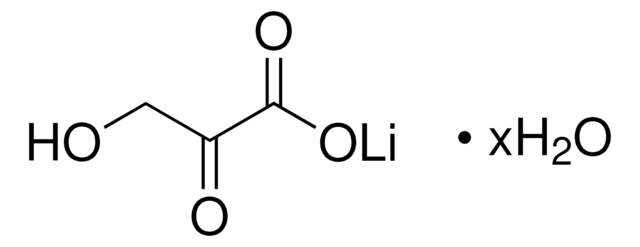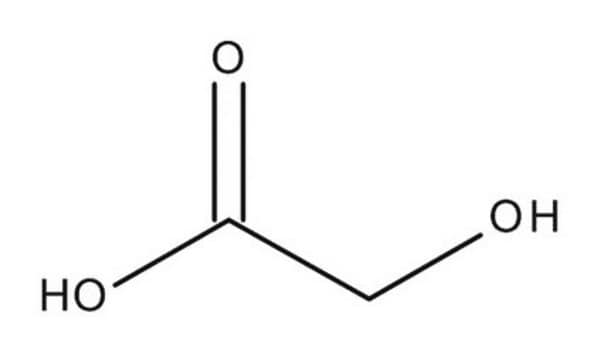06372
β-Hydroxypyruvic acid
≥95.0% (dry substance, T)
Synonyme(s) :
3-Hydroxy-2-oxopropanoic acid
About This Item
Produits recommandés
Pureté
≥95.0% (dry substance, T)
Forme
powder and chunks
Impuretés
≤15.0% water
Température de stockage
2-8°C
Chaîne SMILES
OC(C(CO)=O)=O
InChI
1S/C3H4O4/c4-1-2(5)3(6)7/h4H,1H2,(H,6,7)
Clé InChI
HHDDCCUIIUWNGJ-UHFFFAOYSA-N
Vous recherchez des produits similaires ? Visite Guide de comparaison des produits
Application
- Hydroxy(phenyl)pyruvic acid reductase in Actaea racemosa L.: a putative enzyme in cimicifugic and fukinolic acid biosynthesis.: This study investigates the role of ß-Hydroxypyruvic acid in the biosynthesis of bioactive compounds in Actaea racemosa, highlighting its importance in plant secondary metabolism and potential applications in medicinal chemistry (Jahn and Petersen, 2024).
- The gut microbiota confers protection in the CNS against neurodegeneration induced by manganism.: Research shows the protective role of ß-Hydroxypyruvic acid derivatives produced by gut microbiota against neurodegenerative conditions, providing insights into therapeutic strategies for neurological disorders (Wang et al., 2020).
Actions biochimiques/physiologiques
Mention d'avertissement
Danger
Mentions de danger
Classification des risques
Acute Tox. 4 Oral - Skin Corr. 1B
Code de la classe de stockage
8A - Combustible corrosive hazardous materials
Classe de danger pour l'eau (WGK)
WGK 3
Point d'éclair (°F)
Not applicable
Point d'éclair (°C)
Not applicable
Équipement de protection individuelle
Eyeshields, Faceshields, Gloves, type P3 (EN 143) respirator cartridges
Certificats d'analyse (COA)
Recherchez un Certificats d'analyse (COA) en saisissant le numéro de lot du produit. Les numéros de lot figurent sur l'étiquette du produit après les mots "Lot" ou "Batch".
Déjà en possession de ce produit ?
Retrouvez la documentation relative aux produits que vous avez récemment achetés dans la Bibliothèque de documents.
Les clients ont également consulté
Notre équipe de scientifiques dispose d'une expérience dans tous les secteurs de la recherche, notamment en sciences de la vie, science des matériaux, synthèse chimique, chromatographie, analyse et dans de nombreux autres domaines..
Contacter notre Service technique














